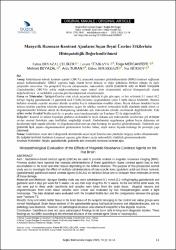Manyetik Rezonans Kontrast Ajanların Sıçan Beyni Üzerine Etkilerinin Histopatolojik Değerlendirilmesi

View/
Access
info:eu-repo/semantics/openAccessDate
2023Author
Çeliker, Fatma BeyazalTümkaya, Levent
Mercantepe, Tolga
Beyazal, Mehmet
Turan, Arzu
Burakgazi, Gülen
Hürsoy, Nur
Metadata
Show full item recordCitation
Beyazal Çeliker, F., Tümkaya, L., Mercantepe, T., Beyazal, M., Turan, A., Burakgazi, G. & Hürsoy, N. (2023). Manyetik Rezonans Kontrast Ajanların Sıçan Beyni Üzerine Etkilerinin Histopatolojik Değerlendirilmesi. Sağlık Bilimlerinde Değer, 13(1), 11-14. https://doi.org/10.33631/sabd.1085947Abstract
Amaç: Gadolinyum tabanlı kontrast ajanlar (GBCA), manyetik rezonans görüntülemelerde (MRG) kontrast sağlamak
amaçlı kullanılmaktadır. GBKA yapısına bağlı olarak beyin dokusu ve diğer dokularda birikim olduğu ile ilgili
çalışmalar mevcuttur. Bu prospektif hayvan çalışmasında, makrosiklik iyonik (Gadoterik asit) ve lineer noniyonik
(Gadodiamide) GBCA'ın çoklu enjeksiyonlarının sıçan santral sinir sistemindeki etkisini histopatolojik olarak
değerlendirmek ve moleküler yapısına göre karşılaştırmak amaçlanmıştır.
Gereç ve Yöntemler: Sprague-Dawley cinsi erkek sıçanlara haftada 4 gün gün aşırı, ve her seferinde 0.1 mmol (0,2
ml/kg) /mg/kg gadodiamide ve gadoterik asid 5 hafta boyunca uygulandıktan sonra 5 hafta ilaçsız bekletildi. Onuncu
haftanın sonunda sıçanlar anestezi altında uyutulup beyin dokusundan örnekler alındı. Beyin dokusu örnekleri beyin
dokusu üzerine yapılmış toksisite çalışmalarına uygun bir şekilde, serebral korteksden farklı alanlarda atipik nöron ve
oligodendositler körleme olarak iki histopatolog tarafından ışık mikroskobu altında skorlanarak değerlendirildi. Elde
edilen veriler Kruskal-Wallis testi ile ve gruplar arası karşılaştırmalar ise Tamhane T2 ile değerlendirildi.
Bulgular: Kontrol ve serum fizyolojik grubuna ait deneklerin beyin dokusu ışık mikroskobik kesitlerinde gri ve beyaz
cevher normal histolojik yapı özellikleri sergilediği izlendi. Gadodiamide uygulanmış grubun beyin dokusuna ait
kesitlerinde tipik yapıda nöronlar ve oligodendrositler mevcut olup herhangi bir patoloji gözlemlenmedi. Gadoterik asit
grubunda tipik yapıda oligodenraositler gözlenmekle beraber birkaç atipik nöron dışında herhangi bir patolojik yapı
izlenmedi.
Sonuç: Gadolinium uzun süreli diagnostik alımlarında sıçan beyin hücrelerinde patolojik bulguya neden olmamaktadır.
Bu bulgular kontrast maddenin kimyasal yapısına göre (lineer ya da makrosiklik ) farklılık göstermemektedir. Aim : Gadolinium-based contrast agents (GBCA) are used to provide contrast in magnetic resonance imaging (MRI).
Previous studies have reported that repeated administrations of linear gadolinium- based contrast agents lead to their
accumulation in the brain and other tissues depending on the GBKA structure. The purpose of this prospective animal
study was to investigate the effect of multiple administrations of macrocyclic ionic (gadoteric acid) and linear nonionic
(gadodiamide) gadolinium-based contrast agents (GBCAs) on rat brain tissue and to compare these molecules in terms
of tissue damage.
Material and Methods: Sprague-Dawley male rats were administered 0.1 mmol (0.2 ml/kg)/mg/kg gadodiamide and
gadoteric acid 4 days per week for 5 weeks. He was then kept drug-free for 5 weeks. At the end of the tenth week, the
rats were put to sleep under anesthesia and samples were taken from the brain tissue. Atypical neurons and
oligodendocytes from brain tissue samples were scored and evaluated by two histopathologists under a light
microscope. The data obtained were evaluated with the Kruskal-Wallis test and the comparisons between the groups
were Tamhane T2.
Results: Gray and white matter tissue in the brain tissue of the subjects belonging to the control and saline groups were
normal histological. Brain tissue sections of the gadodiamide group had typical neurons and oligodendrocytes, and no
pathology was observed. However, no pathological structure was observed except for a few atypical neurons.
Conclusion: Gadolinium does not cause pathological findings in rat brain cells in long-term diagnostic intakes. These
findings do not differ according to the chemical structure of the contrast agent (linear or macrocyclic).

















